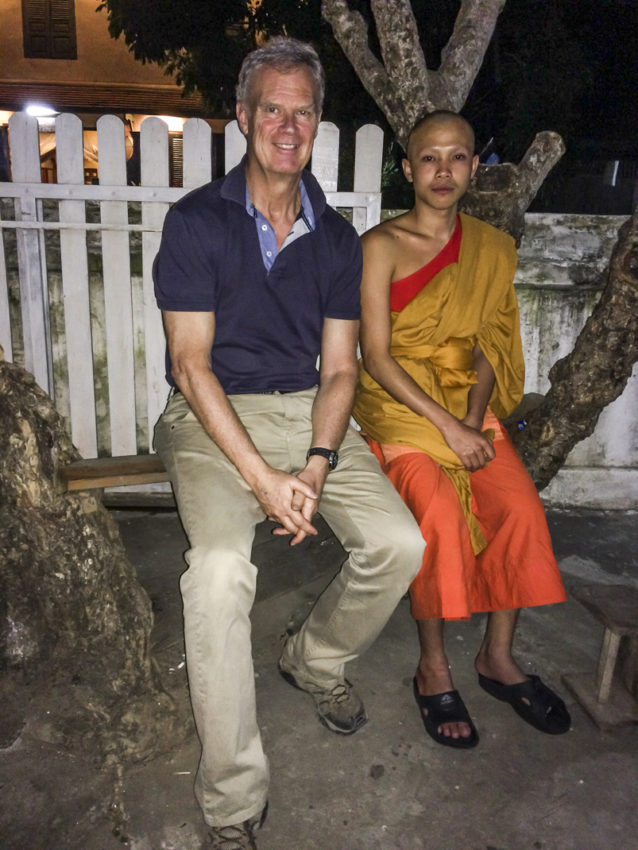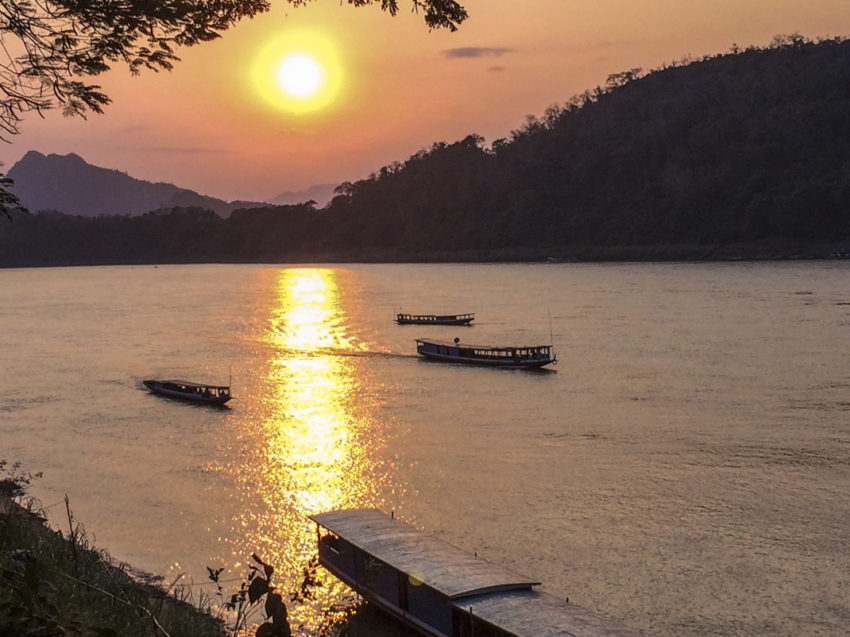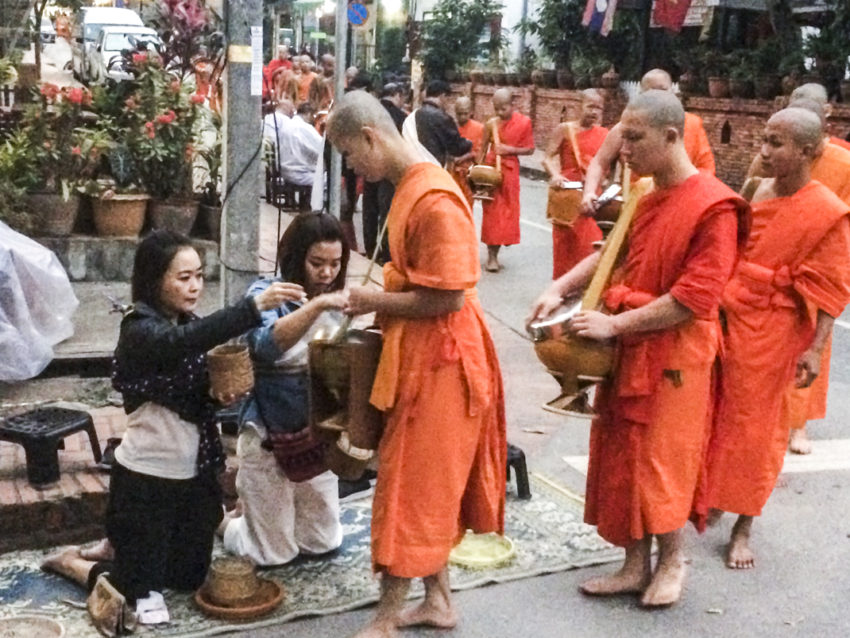An interview with a monk: My time becomes spiritual in Laos’ Buddhism capital

LUANG PRABANG, Laos — I’m writing this on the banks of the Mekong River, in a cafe that wouldn’t look out of place on the banks of the Seine. Maybe it’s the quality of the chocolate croissant and coffee I just had but I feel as tranquil as I did lounging around the streets of Paris on my many visits.
Or maybe, just maybe, it was the conversation I had the night before with a Lao monk. He’s 19 years old and has the maturity and tranquility of a man twice his age. As so many encounters on the road occur, this happened by chance. But in Luang Prabang, the chances of meeting a Buddhist monk are pretty good.
This is the center of Lao Buddhism and has been for more than 500 years. This town, at the confluence of the Mekong and Khan rivers, has so many temples no one has ever made an accurate count. It was once the center of the Lan Xang empire, a Khmer-supported society created in the 14th century. In 1512, Lan Xang’s king accepted Pha Bang, a revered Buddhist image from the Khmer monarchy. Luang Prabang means “Royal Pha Bang.” When Lan Xang broke up in the 17th century, Luang Prabang remained an independent empire separate from Vientiane, Laos’ current capital.
Luang Prabang remained a mechanical and spiritual center, and monks from all over Laos poured in. They’re still here. You notice it as soon as you walk outside. After checking into my 10-euro guesthouse across the street from the Mekong, I walked down the crude stone staircase to the banks of the river. The sun was setting. A sunbeam stretched clear across the river, perfectly illuminating narrow longboats as they came to shore. The mist-shrouded hills in the background added another portrait to the Oriental tapestry through which I’m traveling. If I had a white tablecloth, a bottle of wine and Marina, it would’ve been one of the most romantic scenes of my life. Hell, I would’ve settled for a bottle of Beerlao and a mutant monk.

I walked along the Mekong until it joined the Kahn, then I curled up the street where I started hearing the steady beat of a drum, like the backdrop of a war march. The sun had set and the dull outlines of gold and orange temples started to appear. I walked past Wat Sibounheuang, a huge temple in garish purple, orange and pink. The peacefulness in the golden light made me slow down and ponder one of the most tranquil moments of my trip.
I could hear rhythmic chanting inside, beautiful chanting by young voices. I peered through the narrow windows and could see the temple filled with saffron-robed monks. I stood and listened for a bit then went around to the entrance. About 30 of them, mostly teen-agers, kneeled in front of a huge golden Buddha.
The chanting ended and the monks filed out silently. One came out alone. He was young, thin with a round, kind face.
“Nice singing,” said one of the two other men observing.
“It wasn’t singing,” the young monk said in near perfect English, almost scolding. “It’s chanting. Singing is something else.”
He said his name is Bounnakh. He’s 19 and been at this monastery for five years.
“You speak good English,” I said. “Where did you learn?”
“I taught myself,” he said, smiling proudly while sitting on a crude sitting board stuck between two trees in the courtyard. “TV news. Some books.”
I asked him how he became a monk.
“I come from a village away from here,” he said pointing over some buildings across the street. “My primary school only had two grades. I wanted to continue studying. My parents didn’t have much money. They said, ‘You don’t have to go to secondary school. You can help on the farm.’
I didn’t want to help on the farm.”
He said one day a monk came to his village. Bounnakh told him he wanted to study.
“He said, ‘Yes. Come to the monastery,’” he said.
He was 12 years old and after a two-year study program, he came to the monastery and nas been here ever since. His English was remarkable. He used near perfect grammar and a vocabulary more enriched than any Lao I’ve met my first week. I asked him why he liked being a monk.
“I like to meditate,” he said. “When I first came here. I didn’t know anything.”
I told him about my exasperating experiment with meditation in India two years ago. I went in hoping to stop thinking of ways to kill various people from my past. I left meditation after realizing that during every meditation I wound up going through my to do list.
He smiled.
“It’s hard at first,” he said. “You must learn to breathe.”
“I did.”
“You must breathe deeply and hold it.”
“I did. I even concentrated on the four points of concentration, the chakras, the forehead, heart, belly and waistline.”
“When you first start, only concentrate on one point,” he said. “That’s easier.”
I asked him if he ever experiences stress. He thought for a minute. He crunched his saffron robe in his fist.
“No.”
Then again, if your life is meditation and chanting, what stress can you have? However, I delved deeper. What is the dream of a young monk? I asked. He could do this life until the day he died. I asked him what he wanted to do.
“I want to go to university,” he said. “I want to study computers. Is that good?”
“Yes,” I said. “Very good. It’s the job of the future. Don’t work for a newspaper.”
He didn’t smile. Laos has two newspapers, the state-run communist rag and the Vientiane Times, its English counterpart. Soon, the U.S. may not have many more.
I asked him if he’ll continue being a monk at university. He pointed at his robe and smiled.
“No,” he said. “I want to leave. But I will continue to meditate.”
I shook his soft hand, bid him good luck and continued past another string of temples. This is how the world comes together, an American atheist who continually blasts his new government while basking in the luxury of Rome, meeting a humble young Lao monk with dreams of shedding his robe for the future world of computers. Not surprisingly, I had more in common with him than many fellow Americans: lack of material possessions, a love for other people who aren’t like me, a sense of bliss, a quest for peace.

The next morning, I woke at dawn to join the locals in their daily honoring of Buddhism and the men who represent it. It is called Tak Bat. It is the monks’ call to alms. Every day at dawn, the monks walk the streets of Luang Prabang in silent single file. Locals gather on the street, on their knees, and hand out little gifts: rice, sweets, chocolate. It is the Buddhists’ display of poverty and humility and the locals’ display of spirituality.
I walked up the quiet side street when a middle-aged woman grabbed my arm and rushed me up the way. What, are we fleeing a fire? She pushed a small bucket filled with little sweets and a big bowl of rice into my hand. She motioned me to a street corner where I knelt next to two women with their hands clasped in prayer.
The monks filed past us, each stopping for a moment. I put little balls of rice and wrapped chocolates into their big round bowls. Aged about 12 to 60, they all walked past, unsmiling, unspeaking. Breaking the perfect silence and my perfect mood, the woman who shepherded me here began shrieking, in obviously practiced English, “15,000 KIP! 15,000 KIP!” She wanted the equivalent of almost $2 for the gifts I handed out. Feeling like a rube and my spirituality broken by this blatant act of capitalism, not to mention fraud, I gave her 8,000 — and her bucket — and walked off.
I probably didn’t score many points on the spirituality meter. Bounnakh would not have approved. Yet he gave me a sense of spirituality I couldn’t get by giving. Maybe I’ll give meditation another try.


April 5, 2017 @ 10:22 pm
Can’t believe she did that Tice trick. That’s a new gimic sn DC kind of sad.
April 5, 2017 @ 10:23 pm
Don’t know how all those misspellings got in my comments above.
April 6, 2017 @ 1:19 am
What were you trying to say? I have no idea.